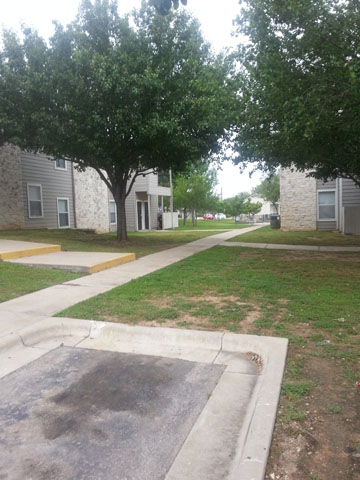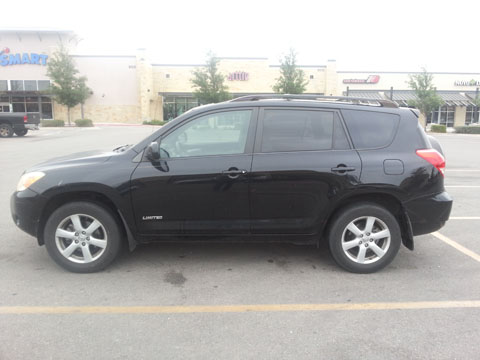
|

|
Alex's photographs were of a variety of different places, though each focused on function. The first place he identified was his bedroom. He said, "This is my home. I guess for me I assume that home would be places I am quite frequently... The place where I sleep and spend my time when I'm not with people seemed the best place to start" (Alex). This suggests that this room serves a multitude of functions. In a study conducted on two different people and their home spaces, the researcher found that, "In Sarah's home, a small number of square metres have to hold many different activities, and thereby the room (the one and only in the apartment) determines behavior less strictly" (Bengtsson 129). Though Alex had three rooms in his apartment he did not use the common room, and so his bedroom served several functions, rather than simply as a place of sleep. As with Annie, in a shared home, his bedroom represented a space of control, a space over which he could make the decision of who could and could not enter. The similarities ended there. His bedroom consisted of his bed, a camping chair, and a television with a gaming system. The gaming system was important to him, and he used it quite often. He described his room as a whole as, "Pretty minimalist...I like the little nook... I wanted to actually redecorate a while ago... but I liked putting money into my savings account" (Alex). This shows a prioritization of practicality over material goods. Still, he identifies what some might see as a sterile environment as comfortable by virtue of its having the things he needed. Similar to Annie, he also identified time spent in a location with home, a theme that carried into the next picture. He explains, "Then I went to the other place I spend a lot of time when I am home, which is in the kitchen, full if all of our crazy gadgetry. I actually spend a lot of time in there...it's weird" (Alex). The "crazy gadgetry" refers to the numerous appliances that line the counters, again showing a preference for functionality, though this time tinted with an idea of seeing consumer goods as markers of identity. The naming of the appliances as "crazy gadgetry" indicates that Alex somehow sees his identity as being the sort of person who would buy these things. Describing the amount of the time he spends in the kitchen ad "weird" also implies a feeling of breaking societal norms that helps to construct his identity. It also reveals objects' role as part of culture. Objects are typically naturalized and seen as whole entities within themselves. As Rosenstein says, "Objects are correlated with nature as opposed to culture" (Rosenstein 140). Sometimes, though, their place in culture peeks through. |
|
In contrast to Kati, the only place Alex shows "nature" is a place closely associated with function. He photographed the edge of the parking lot, an area with a few trees that he walks through daily to reach his apartment. While Katie purposefully diminished the presence of people and human interference in her photographs, Alex included the parking lot in the photograph, exhibiting a priority of function over aesthetic value. The idea of considering the edge of a parking lot and a few droopy trees as something worth photographing makes more sense in light of an observation Darrin Hodgetts made while studying urban life. He writes, "identity of a place can be shaped by the practices that occur there" (Hodgetts 295). In this case, the parking lot is not a parking lot, but the place Alex walks through to get home. This elevates it in his mind, while speaking of the fluidity of place to take on different roles. Alex then identified his car as his second home, as, "The first is the place I sleep, and this is a place I have slept and could sleep in if I needed to" (Alex). He uses it everyday, and it allows him to travel and negotiate public space. In this way, the car allows him to feel in control of his environment (Fraine). The car is a suburban, which is not a typically "cool" choice but he still exhibited great attachment to, explaining that it had gotten him around for several years, was comfortable, could carry many things, and adding that for a suburban, it could go pretty fast. As with the kitchen, this shows first a consideration for functionality simultaneous with an appreciation for other attributes. |

|

|

|
Finally, Alex showed his place of work, Which Which sandwich shop. He has worked there for seven months, and notes that he spends a lot of time there. He does not find the job a particularly enjoyable one, and yet still identified it as home, strengthening the point that he connects home to places of function. Here he functions as an employee. Again, he picked a certain area, the lobby, that he identified with. The lobby is the punctum of the overall studium of Which Which. As an employee he does not use the lobby for its designed purpose-namely, to eat in, but it was still very important to him, so much so that he claimed ownership over it. He said, "This is my lobby after I cleaned it." In response to laughter I could not suppress, he reiterated, "No, this is my lobby. I'm the only person who knows how to clean it properly" (Alex). What marks the lobby as "his" is not control, as with Annie, and not identification with a more ideal location, as with Kati, but rather ownership by proxy of the role he performs in it. Though he did not photograph these places, he also mentioned the facility in which he works out as a source of home. This also relates to the idea of home being bound up in a performative role. |
